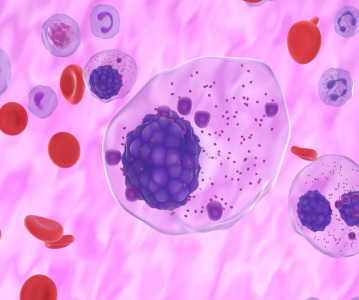Charity and academic collaboration aims to find drug treatment for lymphoma
.jpg)
MALT1 could be a promising drug target for some subsets of lymphoma, including diffuse large B cell lymphoma.
MRC Technology and the University of Lausanne are collaborating to find new drug treatments for diffuse large B cell lymphoma, the most common type of non-Hodgkin lymphoma.
MALT1 (Mucosa-associated lymphoid tissue lymphoma translocation protein 1), an immunomodulatory enzyme, is required for the effective triggering of an immune response. However, dysregulation of MALT1 is also associated with some subsets of lymphoma, including diffuse large B cell lymphoma, suggesting that MALT1 could be a promising drug target for these types of cancer.
Professor Margot Thome-Miazza, Associate Professor, University of Lausanne said: “We have previously identified a novel way of regulating the catalytic activity of MALT1 via a protein modification called ubiquitination. We are now working with MRC Technology to harness this regulatory mechanism and discover small molecule inhibitors that specifically interfere with the ubiquitin-linked form of MALT1.”
Justin Bryans, Director, Drug Discovery, MRC Technology said: “It is encouraging that we can build on the work of the University of Lausanne and bring new treatments to patients. These drugs could potentially also treat other types of lymphoma associated with MALT1 over-activity, for example MALT lymphoma and Mantle Cell lymphoma.”
Céline Lafourcade, Licensing Manager at PACTT (Powering Academia-industry Collaborations and Technology Transfer) explained: “MRC Technology with its unique capabilities constitutes an ideal partner to further develop this innovative technology emanating from academic research.”
MALT1 inhibitors may also have wider therapeutic applications owing to MALT1’s role in immune regulation, and could potentially be used to limit overactive immune reactions in autoimmune diseases.
Related News
-
News BioNTech to begin mRNA vaccine manufacturing in Rwanda by 2025
German biotechnology company BioNTech has stated their intentions to begin production at their mRNA vaccine factory in Rwanda by 2025, which will mark the first foreign mRNA vaccine manufacturing site on the continent of Africa. -
News Identifying Alzheimer’s Disease biomarker proteins with whole blood tests
A University of Manchester spin-out pharmaceutical company, PharmaKure, has reported successful study results for the quantification of Alzheimer’s Disease biomarker proteins with a whole blood test. -
News Bill & Melinda Gates Foundation to boost mRNA vaccine initiatives in Africa with USD $40m
To address vaccine inequality and accessibility issues, the Bill & Melinda Gates Foundation aims to deliver USD $40m to various biotech companies and vaccine manufacturers in support of mRNA vaccine development. -
News CPHI Podcast Series: Exploring neurological frontiers in Alzheimer's and beyond
The next episode of the CPHI Podcast Series delves into the science and background behind some recent developments in the field of Alzheimer's disease and neurological disorders. -
News Is patient centricity the future of pharmaceutical manufacturing?
In this interview with Sandra Sánchez y Oldenhage, President of PharmAdvice, she speaks to the importance of considering patients in the manufacturing stages of the pharmaceutical supply chain, and how it can redefine healthcare. -
News CPHI Podcast Series: How to leverage AI for Drug Discovery
Artificial intelligence is the topic of debate in the latest episode from the CPHI Podcast Series, where Digital Editor Lucy Chard speaks with Bill Whitford of DPS Group about the integration of AI in healthcare. -
News Pfizer forges ahead with blood cancer therapy after approval from FDA
Pfizer gains accelerated approval from the US FDA for their new bispecific antibody therapy for multiple myeloma, set to address an unmet need for patients. -
News Alzheimer's drug donanemab deemed effective in landmark clinical trial
Results from the TRAILBLAZER-ALZ 2 Randomised Clinical Trial into the use of donanemab to treat early symptoms of Alzheimer’s disease have been analysed.
Position your company at the heart of the global Pharma industry with a CPHI Online membership
-
Your products and solutions visible to thousands of visitors within the largest Pharma marketplace
-
Generate high-quality, engaged leads for your business, all year round
-
Promote your business as the industry’s thought-leader by hosting your reports, brochures and videos within your profile
-
Your company’s profile boosted at all participating CPHI events
-
An easy-to-use platform with a detailed dashboard showing your leads and performance







